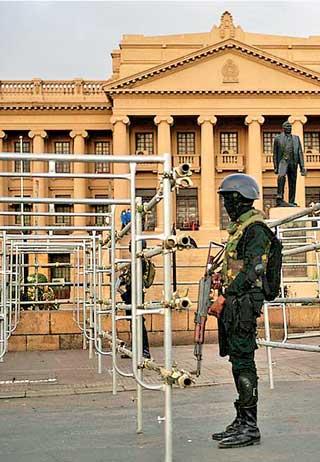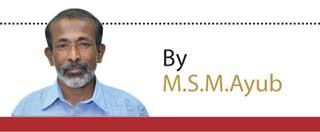30 Jul 2022 - {{hitsCtrl.values.hits}}
Eleven smaller political parties including two led by Wimal Werawansa and Udaya Gammanpila, who had been sacked from the Cabinet in the previous month called on the President on April 1 to form an all-party government to address the political crisis that was fast in the making against the backdrop of the economic crisis

 The ruling Sri Lanka Podujana Peramuna (SLPP) which had almost gone underground for the past five months due to protests against its government have reestablished its authority over the Sri Lankan politics, with the help of President Ranil Wickremesinghe. The party has managed to get reappointed the same Cabinet that had been appointed in May by President Gotabaya Rajapaksa who resigned on July 14 from Singapore, amidst a massive uprising by the people.
The ruling Sri Lanka Podujana Peramuna (SLPP) which had almost gone underground for the past five months due to protests against its government have reestablished its authority over the Sri Lankan politics, with the help of President Ranil Wickremesinghe. The party has managed to get reappointed the same Cabinet that had been appointed in May by President Gotabaya Rajapaksa who resigned on July 14 from Singapore, amidst a massive uprising by the people.
As if they have forgotten the circumstances that forced them to go underground while forcing even the former President to reshuffle his Cabinet twice within one month (between April 18 and May 14), they have started to vilify the agitations by the people who demanded solutions to the issues they had been enduring with and those in the forefront of the agitations. They have been attempting to portray the protests as something that emerged from nowhere and for nothing while identifying the protests with terrorism and fascism.
|
An army soldier stands guard opposite the old parliament complex, the site which was earlier occupied by the anti-government protesters, until the military ejected them through a pre-dawn crackdown |
Forgetting or ignoring the root causes of the protests that almost brought the government to its knees might be counterproductive as they are still stalking us.
The measures taken by the government to counter the COVID-19 pandemic largely affected the economy last year, having a spiraling effect on the cost of living. The Gotabaya Rajapaksa government’s decisions to implement a huge tax cut, to ban imports of agro-chemicals and to assign a fixed value for the dollar while the rupee was fast depreciating aggravated the situation. The decision not to seek assistance of the IMF, the only option left with the government two years ago to face the unprecedented foreign exchange crisis resulted in a huge shortage of fuel and cooking gas which in turn led to a political crisis.
There were intermittent protests organized by Opposition political parties against the rising cost of living during the first half of 2021 and farmers’ protests were seen almost every district with the ban on chemical fertilizer imports in May last year. The leaders of the government who failed to understand the real situation on the ground described those agitations as politically motivated anti-government disruptive actions. Towards the end of last year, a series of cooking gas related explosions were reported from all over the country and when the lethargic attitude of the authorities towards all these problems was clearly evident, there seemed a clear change even in the frame of mind of the supporters of the government.
The fuel shortage caused by the foreign exchange crisis turned the life style of people, especially the middle class and above, upside down, as it resulted in power cuts over ten hours a day in the first few months of this year, apart from creating a huge problem in the transport sector. The outburst of frustration over all these issues first occurred in a massive spontaneous demonstration in front of President Gotabaya Rajapaksa’s private residence in Mirihana in the night of March 31, this year. With it being live streamed by hundreds of people with their mobile phones, soon it became a trend setter as the social media activists, who seemed to have inspired by the activists of Arab Spring, called people for an even larger protest in Colombo on April 3. It was also a success, despite the government having slapped curfew apart from a state of emergency.
Eleven smaller political parties including two led by Wimal Werawansa and Udaya Gammanpila, who had been sacked from the Cabinet in the previous month called on the President on April 1 to form an all-party government to address the political crisis that was fast in the making against the backdrop of the economic crisis. Obliging, the President got his entire Cabinet except for the Premier resigned on April 3 and requested all parties in Parliament to join the government. However, there were no takers for his offer, not even those who suggested the all-party government, apparently due to the public mood.
While the President was struggling to resolve two crises both on the economic and political fronts, another wave of protests started in front of Presidential Secretariat on April 9, this time as a continuous agitation until his resignation. It was a peaceful protest until May 9 which drew acclaim even from the embassies of powerful countries. Nobody called it terrorism or fascism then.
May 9 saw some of the worst violent incidents where supporters of the former Prime Minister Mahinda Rajapaksa attacked the protestors followed by reprisal attacks by the sympathizers of the protest during which a Parliamentarian was beaten to death and many houses of politicians, mainly those affiliated to the government were torched. These incidents resulted in the resignation Mahinda Rajapaksa as the Prime Minister and UNP leader Ranil Wickremesinghe replacing him. Although the protesters had blocked the gates of the Presidential Secretariat, Mr. Wickremesinghe as the Prime Minister stated then that he would instruct the Colombo Mayoress Rosy Senanayake to provide facilities for the “GotaGoGama,” the main protest site in Galle Face Green.
His statement could have either been serious on the grounds that he would constitutionally be the interim President, in case “Gota” really goes or he just meant sarcasm. However, now he says that storming such premises was unlawful and against democracy. Two months passed after that without incidents, except for the various cultural events having taken place in the protest sites in front of Presidential Secretariat and Temple Trees. On the completion of three months since the establishment of the permanent protest site in Galle Face Green, on July 9 protestors called a huge crowd to Colombo which occupied the President’s House, Presidential Secretariat, Temple Trees and the Prime Minister’s Office, along with thousands of people whom they know nothing about and without knowing what their next course of action would be.
An embattled President Gotabaya Rajapaksa resigned on July 14 and Prime Minister Ranil Wickremesinghe as the candidate of the SLPP led by Rajapaksas was elected as his successor by Parliament on July 20. The Galle Face protestors on July 21 announced that they will leave the occupied state buildings next day, July 22, but were attacked and chased away by the armed forces in the early hours of the day they were to leave. Interestingly, the attack was also live streamed by the protestors themselves.
It was not clear as to why such a crackdown was unleashed when the protestors had already announced their vacation of the state buildings. Sometimes, preventing recurrence of such storming of state buildings, especially those that symbolize the authority of the state and rebelling against the government, by way of instilling fear in the minds of the people, might have been meant. And now the protestors are on the run while the SLPP leaders are in the saddle.
Despite their original slogan - Gotagohome” - having been realized, the humiliation suffered by the protestors at the end of this story could be attributed to lack of political leadership, direction and a final destination for the Aragalaya, as the protests were called. They wanted Gotabaya to go, but did not have a strategy to install a corrupt-free administration, instead. It was the Parliament which they called a corrupt institution that decided the next course of action. They mobilized the people for the uprising, but did not have a process for vetting and controlling them, leaving room for killings, arson attacks and vandalism, though the number of such incidents was relatively very small.
However, triumphalism on the part of the SLPP and the government could be counterproductive. One should not forget the root cause of the uprising – the frustration stemmed from the hardships that were inflicted on the people by the economic crisis. It is still a reality on the ground. So long as this issue is not addressed the danger of frustration exploding again would stalk us.
27 Nov 2024 19 minute ago
27 Nov 2024 58 minute ago
27 Nov 2024 1 hours ago
27 Nov 2024 1 hours ago
27 Nov 2024 2 hours ago